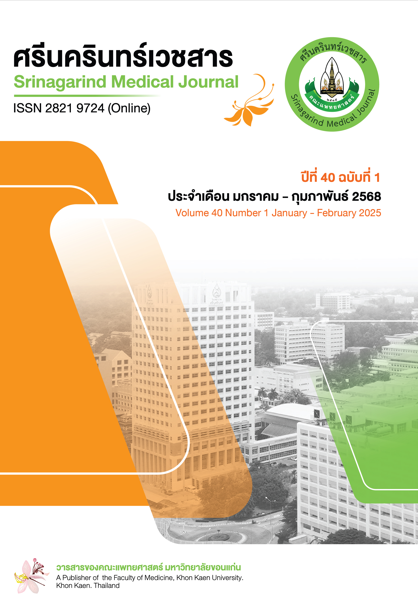หลักฐานเชิงประจักษ์ในการป้องกันความล้มเหลวและการส่งเสริมการอยู่รอดของแผ่นหนังที่ปลูกใหม่ในผู้ป่วยมะเร็งศีรษะและลำคอที่ได้รับการผ่าตัดด้วยวิธีการย้ายเนื้อเยื่อและหลอดเลือดมาสร้างเป็นแผ่นหนัง
คำสำคัญ:
ผู้ป่วยกลุ่มมะเร็งศีรษะและลำคอ, ความล้มเหลวของแผ่นหนังที่ปลูกใหม่, การส่งเสริมการอยู่รอดของแผ่นหนัง, การประเมินแผ่นหนังที่ปลูกใหม่, การผ่าตัดเพื่อนำก้อนมะเร็งออกแล้วนำเนื้อเยื่อและหลอดเลือดมาสร้างเป็นแผ่นหนังบทคัดย่อ
บทความนี้มีวัตถุประสงค์เพื่อนำเสนอหลักฐานเชิงประจักษ์ที่เกี่ยวข้องกับการป้องกันความล้มเหลวของแผ่นหนังที่ผ่าตัดปลูกใหม่และการส่งเสริมการอยู่รอดของแผ่นหนังในผู้ป่วยมะเร็งศีรษะและลำคอมุ่งเน้นการดูแลผู้ป่วยหลังผ่าตัดเป็นสำคัญ กระบวนการทบทวนวรรณกรรมครั้งนี้ใช้รูปแบบการใช้หลักฐานเชิงประจักษ์ทางการพยาบาลของซูคัพ ในปี ค.ศ. 2000 ซึ่งประกอบด้วย 4 ระยะ ในบทความนี้นำเสนอการใช้รูปแบบการใช้หลักฐานเชิงประจักษ์เฉพาะในระยะที่ 1 evidence - trigger phase และระยะที่ 2 evidence – support phase เท่านั้น การดำเนินการระยะที่ 2 จากการสืบค้นจากระบบฐานข้อมูลที่สำคัญ ได้แก่ Pub Med, CINAHL, ScienceDirect, Google Scholar และ ThaiJo ได้งานวิจัย 10 เรื่อง อยู่ในระดับ A จำนวน 7 เรื่อง และระดับ B จำนวน 3 เรื่องแล้วนำมาวิเคราะห์และสกัดสาระสำคัญ สรุปประเด็นจากงานวิจัยได้ 3 ประเด็น คือ 1) ปัจจัยที่มีผลต่อการป้องกันความล้มเหลวของแผ่นหนังที่ปลูกใหม่ 2) การติดตามและเฝ้าระวังความล้มเหลวของแผ่นหนังที่ปลูกใหม่ และ 3) การประเมินและส่งเสริมการอยู่รอดของแผ่นหนังที่ปลูกใหม่ ผลจากการทบทวนได้วิธีปฏิบัติเหมาะสมในกิจกรรมการพยาบาลป้องกันความล้มเหลวของแผ่นหนังและการส่งเสริมการอยู่รอดของแผ่นหนังที่ปลูกใหม่สามารถนำไปใช้ในคลินิกได้
References
WHO International agency for research on cancer. Cancer today GLOBOCAN 2022 [Internet] [cited February 10, 2024]. Available from: https://gco.iarc.who.int/media/globocan/factsheets/populations/900-world-fact-sheet.pdf.
Prasertsom P, Leela-adisorn N, Tangcharoendee N, Aroonpraphan S. Prevalence and incidence of potential malignance disorder and oral cancer by organized community screening model in 5 districts of Roiet province. Thai Dental Public Health Journal 2018;23(2):46-54.
Prayalaw S, Manokhoon K, Chathongyot N, Prasanchum P. Development of a nursing care model for patients with head and neck cancer receiving chemo-radiotherapy. Journal of Nursing a Health Care 2019;37(4):244-252.
Choengprapakorn D, Rattanaphan P, Pattanittum P, Klungtong A. Comparison of venous thrombosis in different venous systems for anastomosis in radial forearm free flap: a systematic review and meta-analysis. Khon Kaen University Dental Journal 2022;25(2):38-49.
Sophon K. Oral cancer. Udonthani Center Hospital 2016;14(60):1-14.
Vincent A, Sawhney R, Ducic Y. Free tissue transfer reconstruction: perioperative care of free flap patients. Seminars in Plastic Surgery 2019;33(1): 5-12. doi:10.1055/s-0038-1676824.
Kaner D, Mouaz S, Han Z, Georg G, Anna S, Anton F. Early healing events after periodontal surgery: observations on soft tissue healing, microcirculation, and wound fluid cytokine levels. Int J Mol Sci 2017;18(2):1-14. doi:10.3390/ijms18020283.
Zhou W, Zhang WB, Yu Y, Wang Y, Mao C, Guo CB, et al. Risk factors for free flap failure: a retrospective analysis of 881 free flaps for head and neck defect reconstruction. Oral Maxillofacial Surg 2017;46(8): 941-945. doi:10.1016/j.ijom.2017.03.023.
Dort JC, Farwell DG, Findlay M, Huber GF, Kerr P, Shea-Budgell MA, et al. Optimal perioperative care in major head and neck cancer surgery with free flap reconstruction: a consensus review and recommendations from the enhanced recovery after surgery society. JAMA 2017;143(3): 292–303. doi:10.1001/jamaoto.2016.2981.
Varadarajan VV, Arshad H, Dziegielewski PT. Head and neck free flap reconstruction: what is the appropriate post-operative level of care. Oral Oncol 2017;75(2017): 61-66. doi:10.1016/j.oraloncology.2017.10.022.
Chen WC, Hung KS, Chen SH, Shieh SJ, Lee JW, Hsiao JR, et al. Intensive care unit versus ward management after anterolateral thigh flap reconstruction after oral cancer ablation. Annals of Plastic Surgery 2018;80(2S Suppl 1): S11–S14. doi:10.1097/SAP.0000000000001301.
Dempsey L, Orr S, Lane S, Scott A. The clinical nurse specialist’s role in head and neck cancer care: United Kingdom National multidisciplinary guideline. J Laryngol Otol 2016;130(32):S212-15. doi:10.1017/S0022215116000657.
Vasilescu D. Guidelines for post-operative care and monitoring for free flap. Archives of the Balkan Medical Union 2016;51(2):251–4.
Coyle MJ, Main B, Hughes C, Craven R, Alexander R, Porter G, et al. Enhanced recovery after surgery (ERAS) for head and neck oncology patients. Clin Otolaryngol 2015;41(2): 118-126. doi:10.1111/coa.12482.
Ong H, Spellman J, and Kanatas A. Skills and competences needed by nurses to allow them to deliver a safe nurse-led oral and maxillofacial oncology clinic: the Leeds experience. Br J Oral Maxillofac Surg 2020;58(9): e3-e5. doi:10.1016/j.bjoms.2020.06.020.
Soukup M. The center of advance nursing practice evidence-based practice model promoting the scholarship of practice. Nurse Clin North Am 2000;35(2): 301-9.
Craig JV, Smyth RL. Evidence-base in nursing. In: Jean V Craig and Rosalind L Smyth. The evidence-based practice manual for nurses. United Kingdom: Churchill Livingstone, 2002: 3-16.
Joanna Briggs Institute. JBI Grades of Recommendation [Internet] [cited March 10, 2021]. Available from: https://joannabriggs.org/sites/default/files/2019-05/JBI-grades-of recommendation_2014.pdf.
The Ottowa hospital. Free flap head and neck surgery [Internet] [cited December 15, 2021]. Available from: https://www.ottawahospital.on.ca/en/documents/2017/06/cp-109-b-english-free-flap-head-and-neck-surgery-dec-2016.pdf/.
Kucur C, Durmus K, Uysal I O, Old M, Agrawal A, Arshad H, et al. Management of complications and compromised free flaps following major head and neck surgery. Eur Arch Otorhinolaryngol 2016;273(1): 209–13. doi:10.1007/s00405-014-3489-1.
Goh SC, Kok YO, Yong PC, Tan WE, Goh L, et al. Outcome predictors in elderly head and neck free flap reconstruction: a retrospective study and systematic review of the current evidence. J Plast Reconstr Aesthet Surg 2018;71(5):719-28. doi:10.1016/j.bjps.2017.12.011.
Zhong T, Neinstein R, Massey C, McCluskey S, Lipa J, Neligan P, Hofer S. Intravenous fluid infusion rate in microsurgical breast reconstruction: important lessons learned from 354 free flaps. Plast Reconstr Surg 2011;128(6):1153-60. doi: 10.1097/PRS.0b013e318221da56.
Hwanga MS, Brittb CJ, Vilac PM, Dangc MP, Flemingd SI, Patela AM, et al. Factors associated with skin graft takes in fibula and radial forearm free flap donor sites. Am J Otolaryngol 2020;41(4):102536. doi:10.1016/j.amjoto.2020.102536.
Harprit KM, Roshan T, Indrani HC. Retrospective review of anesthetic management of free flap reconstructive surgeries: an analysis of 162 cases. Res Innovat Anesthesia 2021;6(1): 1-4. doi:10.5005/jp-journals-10049-0067.
Downloads
เผยแพร่แล้ว
How to Cite
ฉบับ
บท
License
Copyright (c) 2025 ศรีนครินทร์เวชสาร

This work is licensed under a Creative Commons Attribution-NonCommercial-NoDerivatives 4.0 International License.



